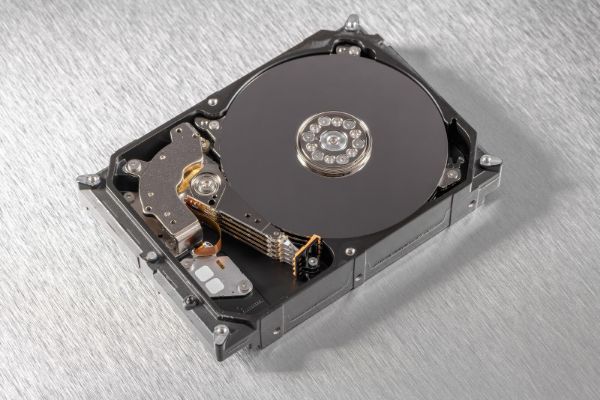Disclaimer: This post may contain affiliate links, meaning we get a small commission if you make a purchase through our links, at no cost to you. For more information, please visit our Disclaimer Page.
Macintosh computers from Apple have become increasingly popular over the years. Part of this is branding and name recognition, and there are many users who seem to appreciate the operating system that separates itself from Windows, the proprietary technology or features that the company develops, and the dedicated support network that is familiar with all things Apple.
As with any computer, one of the most important components in a Mac is the hard disk drive. Often just referred to as the HDD, the disk drive stores all of the information that you might want to put on the computer, and it also includes system files for OS communications as well. Although mechanical hard drives are common, non-mechanical solid-state drives have risen in popularity in recent years, too.
Our article here will cover whether you need an HDD or SSD for a Mac computer. On related notes, we will also cover how a user might replace one drive or the other, whether it is possible to operate a MacBook without either of these kinds of drives, how you might run a MacBook or MacBook Pro from an external hard drive, and some errors related to the computer shutting down unexpectedly.
Table of Contents
Do You Need a Hard Drive or SSD for a Mac?
Technically, you can boot a Mac without a hard drive. However, before we get into that, we need to explain what hard drives or SSDs are. Although you might be able to set up an operating system without a traditional drive or SSD, they are important components of almost any computer, and there are good reasons for making sure that you have them in working order.
The hard or solid-state drives are data storage centers for the computer. They work in conjunction with many other parts, but they are closely related to the central processing unit. The CPU is something like the brain of the computer, and it performs calculations and logic functions that allow the operating system to do its job.
However, it needs somewhere to store this information. Additionally, you need space to store your own files. These files might include text, audio, video, images, and more.
Without any such space, there is nowhere for the data to go. For short-term operations, much of this data can go to your computer’s random-access memory, which allows it to be spun up and recalled quickly as needed. When your Mac’s brain needs to store items or data for a much longer time, it gets written to the hard disk drive.
This allows the data to be in a more permanent state on your system. When you’re using the computer, it can transfer some of this information to the RAM as a way to help you access or edit it more quickly.
When we mentioned that you could boot up a Mac without a hard drive, there is still a caveat to consider. No computer can run its operating system without some kind of storage from which to boot. In most cases, this is going to be the hard drive or solid-state drive of your choice.
However, it is possible to boot a Mac that doesn’t have one of these. In such cases, you would still need to use a disc, external drive, or some kind of USB drive that has storage on it. Some of that storage would have information written to it to allow the Macintosh operating system to boot.
Can You Replace a Hard Drive or SSD on a Mac?
Yes, you can replace the standard or SSD drives in a Mac. Some users might find that Mac computers can be a little difficult to work with, repair, or upgrade, but many of the same basic principles for swapping out standard parts apply to Macs in the same ways that they do any other computers. Before you begin this process, it is important to have the things you need on hand.
You’ll also want to make sure that you understand how to get into your Mac computer, take out the drive you want to swap, insert the other one, and close everything up. That way, you can be reasonably sure that the computer will start and recognize the new drive without having to go into it again to mess around with anything.
We will give you some basic guidelines here. You should gather at least a T8-style screwdriver, but you may need a whole set at your disposal. If you look at the make and model of the computer you have, you should be able to find out which kinds of screws you’ll need to remove and reattach later. You should also have a USB-C cable that is able to support data transfer and power by itself.
If you’re replacing a drive on a MacBook or Pro, having another computer that can run macOS and the Apple Configurator will be instrumental in making this process go more smoothly. The steps we provide here will be basic guidelines, but you can find more detailed instructions by going here.
- Shut the computer down and give it a few minutes to cool off.
- Except for the power cord, disconnect all the cables from your computer.
- Touch the casing to discharge any static electricity you may be carrying, then disconnect the power cord.
- Unlock and remove the housing on the Mac.
- Take out the drive.
- Slide the new modules in place by following the detailed instructions.
- Replace the housing and secure the latches on it.
- Reconnect all the cables except for the power one.
- Plug in the monitor, and check that the firmware will be updated as well.
- Use the USB-C cable to connect the two Macs to each other.
- Load up the Apple Configurator to restore the firmware.
Can You Use a MacBook Without a Hard Drive or SSD?
The answer to this question depends on what one might mean when they talk about using a MacBook. As we touched on above, it is possible to boot a computer from other sources.
However, you still need some storage for data. The computer will ask you for a boot device, and it is here that you would usually use the HDD or SDD where this data is stored in order to start the machine.
You can have a boot device stored elsewhere, though. Provided you have some kind of device like this that your computer recognizes, and you have the ability to store data or files, you can use a MacBook without a traditional drive. It does need some kind of storage, so you are still limited to options that can act as bootable drives for the macOS version of your choice.
Can I Run My MacBook From an External Hard Drive?
In most cases, you can run a MacBook from an external hard drive. There are some older computers in this line that use processors that may not support this function. However, most any modern MacBook should be able to boot from and use an external drive that you’ve managed to set up.
In fact, you can even use a cloning program to copy an existing drive that you have in your MacBook to an external one. This is one way you can provide yourself with data redundancy in the event of hard drive failure.
When you boot a MacBook in this way, you may need to select the external drive in order to get the system to start. The computer will look for a device from which to boot, and it may not find the external drive by itself.
Why Does My Mac Shut Down When I Connect a Hard Drive?
There are some cases in which a Mac seems to not like a particular hard drive. The reasons can vary, but there are a few things you can look for to see if you can solve the problem.
One of the easiest things to check for is a fault in the cable somewhere. If you’re connecting an external hard drive that you just need to plug into the computer, try swapping out its cable to see if that doesn’t solve the issue.
If you’re still having a problem after trying a different cable, it is possible that the external drive is overloading the computer’s system with too much power. One way to test this is to see if the same drive still works with other computers, should you have any available.
If you find that it still causes these other machines to crash, then it might be a power issue with the external drive itself. Otherwise, the culprit could also be failure of the SATA card.
Conclusion
Whether you prefer traditional hard drives that run mechanically or solid-state ones with no moving parts, it is clear that these storage devices are integral to the proper function of a Mac computer.
While you can produce some substitutions that should work just as well in a pinch, the Mac needs something storage-related from which it is able to boot.
If you have nothing like this at all, the computer will beep at you and ask where everything went. There are ways to run a Mac without one of these drives, but you’ll need a different source that can produce the same functions and results.


